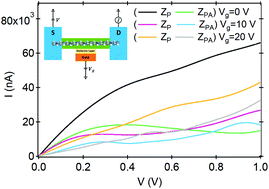Two-dimensional C3N based sub-10 nanometer biosensor†
Abstract
Detection and sequencing of various nucleobases are of immense usefulness that can revolutionise future medical diagnostics procedures. In this regard, the newly discovered 2D material, C3N, has demonstrated supreme potential for future nanoelectronic and spintronic developments due to its unique sets of electronic properties and structural similarity to graphene. Herein, we have investigated the effect of various nucleobases in the close vicinity of a C3N nanoribbon. Our extensive calculations revealed significant changes in the transport behaviour in the presence of DNA/RNA molecules. The transport response can be further modified through the (i) incorporation of doping, (ii) presence of defects, (iii) concentration of the adsorbed molecule, etc. Furthermore, in the presence of a gate voltage in a field-effect transistor (FET) geometry, the conductivity response can be improved significantly with an ∼100% change in the presence of an adsorbed molecule. The observation of a negative differential resistance (NDR) in the C3N system has also been reported here for the first time. Our current observation demonstrates the usefulness of the C3N system as a next generation bio-sensor for the sequencing of various nucleobases, offering new leads for future developments in bioelectronics, superior sensing architectures and sustainable designs.



 Please wait while we load your content...
Please wait while we load your content...